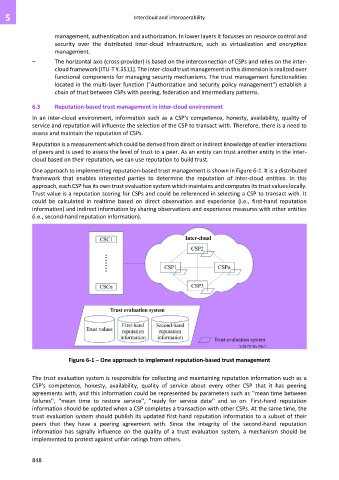Page 856 - Cloud computing: From paradigm to operation
P. 856
5 Intercloud and interoperability
management, authentication and authorization. In lower layers it focusses on resource control and
security over the distributed inter-cloud infrastructure, such as virtualization and encryption
management.
– The horizontal axis (cross-provider) is based on the interconnection of CSPs and relies on the inter-
cloud framework [ITU-T Y.3511]. The inter-cloud trust management in this dimension is realized over
functional components for managing security mechanisms. The trust management functionalities
located in the multi-layer function ("Authorization and security policy management") establish a
chain of trust between CSPs with peering, federation and intermediary patterns.
6.3 Reputation-based trust management in inter-cloud environment
In an inter-cloud environment, information such as a CSP's competence, honesty, availability, quality of
service and reputation will influence the selection of the CSP to transact with. Therefore, there is a need to
assess and maintain the reputation of CSPs.
Reputation is a measurement which could be derived from direct or indirect knowledge of earlier interactions
of peers and is used to assess the level of trust to a peer. As an entity can trust another entity in the inter-
cloud based on their reputation, we can use reputation to build trust.
One approach to implementing reputation-based trust management is shown in Figure 6-1. It is a distributed
framework that enables interested parties to determine the reputation of inter-cloud entities. In this
approach, each CSP has its own trust evaluation system which maintains and computes its trust values locally.
Trust value is a reputation scoring for CSPs and could be referenced in selecting a CSP to transact with. It
could be calculated in realtime based on direct observation and experience (i.e., first-hand reputation
information) and indirect information by sharing observations and experience measures with other entities
(i.e., second-hand reputation information).
Figure 6-1 – One approach to implement reputation-based trust management
The trust evaluation system is responsible for collecting and maintaining reputation information such as a
CSP's competence, honesty, availability, quality of service about every other CSP that it has peering
agreements with, and this information could be represented by parameters such as ''mean time between
failures'', ''mean time to restore service'', ''ready for service date'' and so on. First-hand reputation
information should be updated when a CSP completes a transaction with other CSPs. At the same time, the
trust evaluation system should publish its updated first-hand reputation information to a subset of their
peers that they have a peering agreement with. Since the integrity of the second-hand reputation
information has signally influence on the quality of a trust evaluation system, a mechanism should be
implemented to protect against unfair ratings from others.
848

